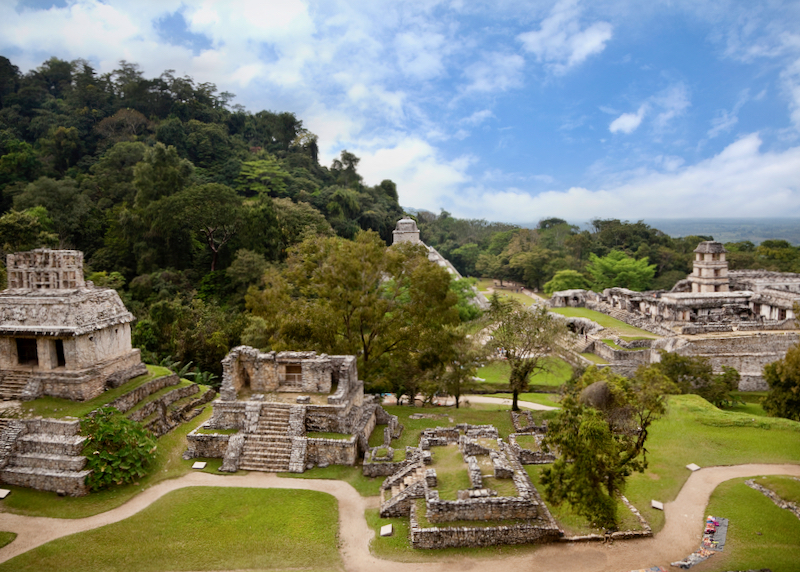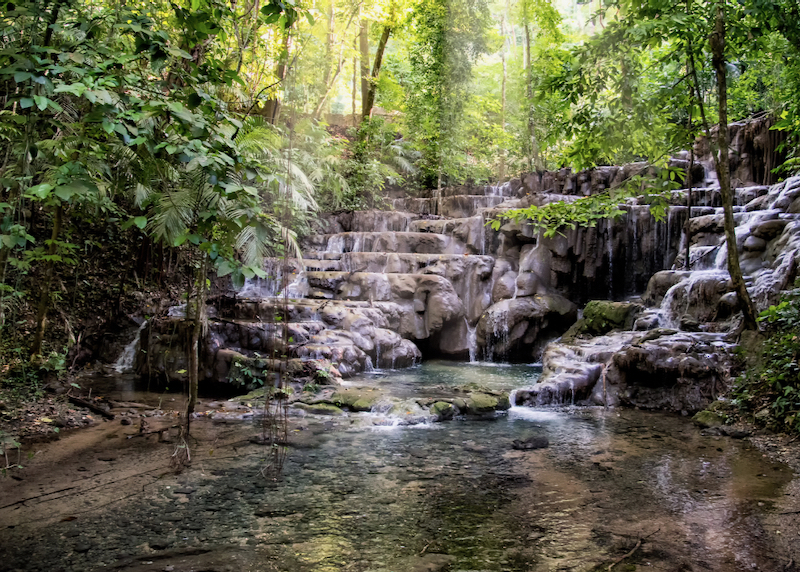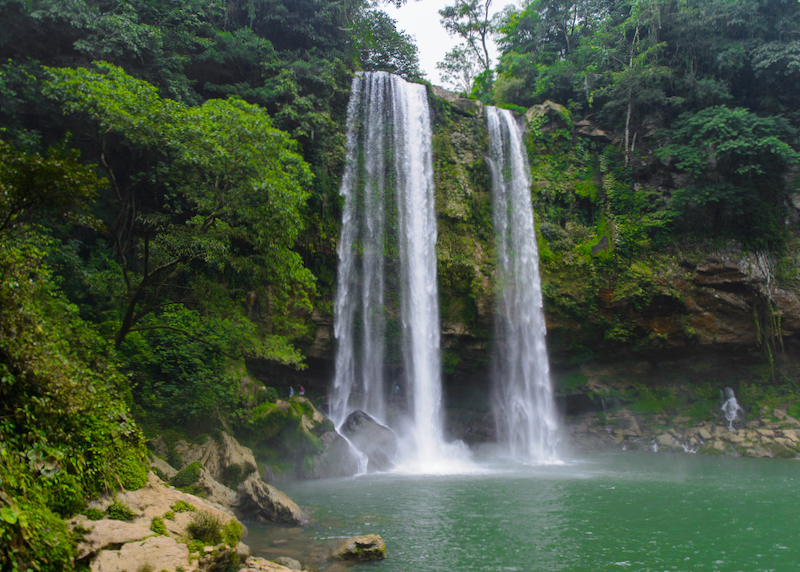Mexico › Best Places to Stay in Palenque
Updated: March 2, 2022
See Also
Palenque is a small city in southeastern Mexico, best known for its sensational Maya ruins, set on the edge of the rainforest, buzzing with colorful birds and the haunting cries of howler monkeys.
Frequently Asked Questions about Palenque

The ancient Mayan ruins complex of Palenque, a UNESCO World Heritage Site in the rain forest of Chiapas.
Where is Palenque?
Palenque is a small modern city and adjacent archeological site in the southeastern Mexico state of Chiapas. Palenque lies around 270 km northeast of the Chiapas state capital Tuxtla Gutiérrez, 210 km northeast of San Cristobal de las Casas, 900 km southeast of Mexico City, and 835 km southwest of Cancún. Non-stop flights to Palenque take 1 hour 30 minutes from Mexico City.
How big is Palenque?
Palenque has a population of around 42,000, including a large Ch’ol (Maya) indigenous community. The city proper covers a relatively small area and is surrounded by rainforest. The archeological site and ancient Maya ruins of Palenque lies some 8 km southwest of the modern city center.
What is the history of Palenque?
The modern city of Palenque was formally established by Spanish missionary Pedro Lorenzo in 1567, as part of an effort to convert the rural Maya population to Christianity. It remained relatively isolated in the rainforest and was only designated a town in 1813 (it became a city in 1972). The main roads were finally paved in 1990. The ancient Maya city of Palenque is much older, and was already abandoned when the Spanish arrived (the Spanish discovered the ruins in 1740). The earliest remains at Palenque date from around 300 BC, but the city was at its peak in the Maya Late Classic Period (c. 600–900 AD). Not much is known about the people that once lived here, though a list of kings, beginning with K’uk’ Bahlam I (431–435 AD), has been uncovered. The most famous king was Pakal the Great (615–683 AD), who initiated much of Palenque’s later construction. Palenque was abandoned by the Maya sometime in the 9th century, for reasons that are still unknown, though the most recent theories have focused on ecological factors, such as long-term drought.
How do I get to Palenque?
Palenque Airport (about 5 km northwest of the city center) serves just one route, the Interjet service from Mexico City – take a taxi into the center from here (250–300 pesos). Otherwise most travelers arrive by bus. Buses to Palenque from Campeche (5 hours 35 minutes); Cancún (around 13 hours); Mexico City (around 14 hours 30 minutes) and San Cristóbal (5 hours) arrive at the first-class bus terminal on the traffic circle in the center of the city, within walking distance of many hotels. Another option is to take a guided tour of Palenque from San Cristóbal de las Casas (via the waterfalls at Agua Azul), and ask to be dropped off in Palenque instead of returning to San Cristóbal. Hiring a taxi/driver is also possible but expensive; reckon on US$100–150 from San Cristóbal (5 hours) or a bit less from Villahermosa Airport in Tabasco (just 2 hours).
Is the overland route safe?
The main road to Palenque (north from San Cristóbal and south from the Yucatán) can be subject to closures by the local indigenous communities (during disputes with the government) and can result in lengthy delays – check the current situation at your hotel before buying tickets. Hold-ups of buses are very rare but can happen at night – robberies on buses at night have also been reported. Taking first-class ADO bus services during the day should ensure a safe trip.
What about Uber?
Uber does not yet operate in Palenque.
Can I drive to Palenque?
Yes, but it’s not recommended. It’s almost 1000 miles (1610 km) to Brownsville, Texas, and the roads in Chiapas can be rough (and unsafe at night). Drivers also need a Mexican “Temporary Importation of Vehicle Permit”.
Do I need a car in Palenque?
No. The center of the city is very small and easy to walk around on foot. The only journey requiring transport is the 8 km (or less, if staying in a hotel on route) ride to and from the Maya ruins; small minivans (colectivos) zip between the city center and ruins every few minutes (operated by Transportes Palenque). Just flag them down (around 35 pesos). Taxis are also plentiful in town and charge around 120 pesos for the ride to the ruins – fix the price before getting in.
When is the best time to go to Palenque?
November to February, when the weather is warm and relatively dry. Palenque has a tropical climate – it’s very hot March to May, and humid and rainy June to October, though the hotels will be a little cheaper at this time. Avoid Christmas and Easter, when domestic tourists pour into Palenque.
Where should I stay in Palenque?

‘The Queen’s Bath’ waterfall in the forest within the Palenque Archaeological Zone.
There are three main choices in terms of area: the busy city center near the main plaza; the more residential and quieter neighborhood of La Cañada, just north of the bus station; and along the jungle-lined road to the ruins.
The city center offers the cheapest rates and proximity to services (banks, tour companies, laundries, restaurants and so on). We like the modern Hotel Maya Rue, on Aldama, between Juárez and 5 de Mayo, two blocks from the main plaza, and the newer Casa 5 B&B at Emilio Rabasa 45.
La Cañada is a bit more upmarket, and is a lot more tranquil – this is a good compromise as it’s still within walking distances of most services and restaurants. Recommended options here include Maya Tulipanes at Cañada 6, which has a pool, and friendly Hotel Museo Xibalba at Merle Green 9, which has a roof terrace.
The hotels on the road to the ruins tend to be better quality and more expensive – obviously more convenient for the ruins (there’s not much to see in town anyway), but less choices when it comes to eating and services, without zipping back and forth into town. Top of the pile is the luxurious Quinta Chanabnal (2 km from the city center), while the more affordable but recommended Chan-Kah Resort Village (3 km from the center) has the most attractive pool in Palenque.
What are the best things to do in Palenque?
There’s only one reason to come here – the ancient Maya ruins of Palenque (officially “Zona Arqueológica Palenque”), some of the most atmospheric in Mexico (there’s nothing to see in the modern city of Palenque). Though the ruins here resemble the Maya sites in Guatemala, Palenque developed its own distinctive architectural style. Highlights include the huge “Templo de las Inscripciones” step-pyramid (which still contains the original sarcophagus of Pakal the Great), and the unique square tower and beautiful relief carvings of “El Palacio”. The site’s location is also fabulous, surrounded by jungle-smothered hills, with stunning views of the pancake-flat Yucatán peninsular visible from the pyramids.
Palenque’s excellent museum, 1.5 km before the main entrance to the ruins, offers the best introduction to the site and displays many of the most important artifacts found here, including a replica of Pakal the Great’s engraved sarcophagus lid. The ruins are open daily and cost 80 pesos.
What are the best things to do around Palenque?

The amazing Misol-Há waterfall. There is a pathway to walk behind the cascade, and you are able to swim in the pool below.
Numerous tour companies offer similarly priced trips to attractions around Palenque, notably the waterfalls at Agua Azul and Misol-Há. These are both beautiful and worth seeing – Agua Azul is the bigger and more developed site (and can be mobbed during holidays), while you can swim safely in the pool of water at the bottom of the falls at Misol-Há. Much longer day-trips take in the Maya ruins of Bonampak and Yaxchilán – both spectacular sites and well worth the time and expense (it’s much easier to visit these sites on a guided tour than solo). Recommended local operators include Na Chan Kan and Turistica Chambajlum.
What are the restaurants like?
Nothing special, but there are plenty of cheap places serving typical Mexican food and international favorites such as pasta and pizza in the city center, and better restaurants attached to the bigger hotels. Some of our favorites include Café de Yara in the city center (Hidalgo 66), which serves excellent coffee and breakfasts, then morphs into a fun bar at night. For no-frills but cheap and tasty Mexican food, try Taquería Tropitacos at Central Poniente 49, a block west of the main plaza. In La Cañada our go-to for Mexican staples is Maya Cañada Felíz (Merle Green 10), while Don Mucho (Carretera Ruinas-Palenque km 4.5) on the road to the ruins has relaxed outdoor seating, a decent international menu, and nightly live music.
What currency is used in Palenque?
The Mexican peso (often pre-fixed with a “$” sign) is the currency of Mexico and used in Palenque – businesses will generally not accept US dollars. Bring lots of pesos to Palenque – some shops and restaurants accept credit cards, but many don’t, and for bus trips and small purchases like bottled water and snacks, cash is king.
Where to change money in Palenque?
Using local ATMs will generally be cheaper than changing money at hotels or at casa de cambios (which will take a commission). Several banks along Juárez in the city center have ATMs – these will usually have cash Monday to Friday during bank opening hours, but can run out at night or at the weekends. There’s also an ATM at the bus terminal, but we don’t recommend using this (or any other ATM not attached to a bank branch), as these can get hacked by credit card scammers.
Is Palenque expensive?
No – hotels are good value and unless it’s a public holiday in Mexico, competitively priced. Budget airbnb deals are also a viable option. The local restaurants and buses/taxis are cheap, and the ruins are less than US$4 to enter.
Is Palenque safe?
Yes. Palenque itself has generally avoided the drug violence that has affected other parts of Mexico. Take the usual precautions, especially at night, and keep your valuables in room safes.
Read More
- Cancun – Best Hotels
- Cancun – Family Hotels
- Isla Mujeres – Best Hotels
- Isla Mujeres – Family Hotels
- Los Cabos – Travel Guide
- Los Cabos – Best Hotels
- Los Cabos – Family Hotels
- Mazatlan – Best Hotels
- Mazatlan – Family Hotels
- Playa del Carmen – Best Hotels
- Playa del Carmen – Family Hotels
- Puerto Vallarta – Best Hotels
- Puerto Vallarta – Family Hotels
- Punta de Mita – Best Hotels
- Sayulita – Best Hotels
- Tulum – Best Hotels
- Tulum – Family Hotels